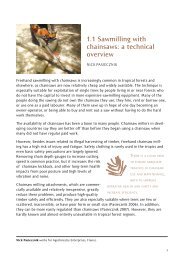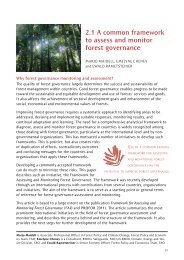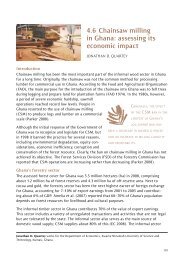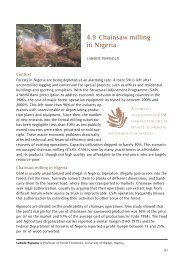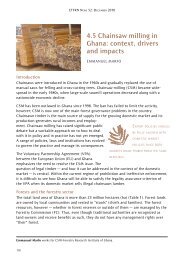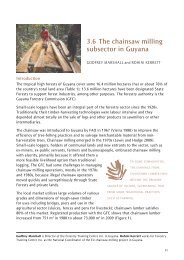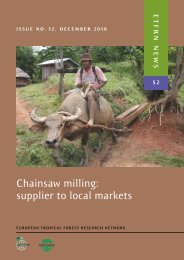Chainsaw milling: supplier to local markets - European Tropical ...
Chainsaw milling: supplier to local markets - European Tropical ...
Chainsaw milling: supplier to local markets - European Tropical ...
You also want an ePaper? Increase the reach of your titles
YUMPU automatically turns print PDFs into web optimized ePapers that Google loves.
4.7 chaiNsaw milliNg iN kENya<br />
Drivers and impacts of chainsaw <strong>milling</strong><br />
Three on-farm sawing methods are commonly used: chainsaws, mobile bench saws and pit<br />
saws (muthike 2004). Csm is preferred because it is faster than pit sawing, it requires only<br />
one opera<strong>to</strong>r and at most an assistant, and it is cheaper and less limited by terrain than<br />
trac<strong>to</strong>r-pulled bench saws (oksanen, pajari and Tuomasjukka 2002). when operated freehand,<br />
however, Csm has a low mean recovery rate (holding, njuguna and Gatundu 2001),<br />
due <strong>to</strong> the wide chain kerf, machine vibration and <strong>to</strong> some extent <strong>to</strong> the lack of opera<strong>to</strong>r<br />
skills (Table 2). a large amount of wood is lost in form of sawdust (muthike 2004). Freehand<br />
<strong>milling</strong> also results in a poor surface finish.<br />
Table 2. Mean comparison results for sawing methods and training<br />
sawing method mean recovery,<br />
untrained opera<strong>to</strong>rs<br />
mean recovery,<br />
trained opera<strong>to</strong>rs<br />
chainsaw 23.30 30.20<br />
mobile bench saw 27.40 35.05<br />
source: muthike 2004<br />
unlike large-scale industrial harvesting and processing techniques, on-farm methods are<br />
often inefficient. <strong>Chainsaw</strong>n timber is generally of poor quality. users have <strong>to</strong> purchase<br />
larger dimensions than required <strong>to</strong> allow for the excessive planing needed <strong>to</strong> obtain a<br />
consistent thickness and acceptable finish. This is partly because chainsaw opera<strong>to</strong>rs are<br />
unskilled, inexperienced or drink alcohol <strong>to</strong> overcome fatigue while sawing.<br />
<strong>Chainsaw</strong> <strong>milling</strong> has a number of social and economic benefits, however. The main social<br />
impacts include <strong>local</strong> employment opportunities and business opportunities, provision<br />
of building materials and adding value <strong>to</strong> farm trees. with improved sawing systems and<br />
training, the social and economic impacts of Csm could be<br />
increased <strong>to</strong> include improved timber recovery, high-quality<br />
timber, opera<strong>to</strong>r safety and improved income. on-farm<br />
timber processing is likely <strong>to</strong> continue as tree growing is<br />
promoted and demand for timber is rising.<br />
chainsaw ownership and benefit-sharing<br />
Csm in kenya is a lucrative business in areas with trees on<br />
farms and near forests. a variety of ownership structures<br />
exist:<br />
• in most cases, people purchase chainsaws and employ<br />
opera<strong>to</strong>rs. when a sawing job is found, the chainsaw owner buys fuel and lubricant<br />
and pays the tree owner, based on either running foot of timber or amount of fuel<br />
used. The payment is shared in three equal parts: <strong>to</strong> the machine owner as profit; <strong>to</strong><br />
repay the cost of fuel and maintenance of the chainsaw; and split by the opera<strong>to</strong>r<br />
and the assistant (at a ratio of 2:1).<br />
171



